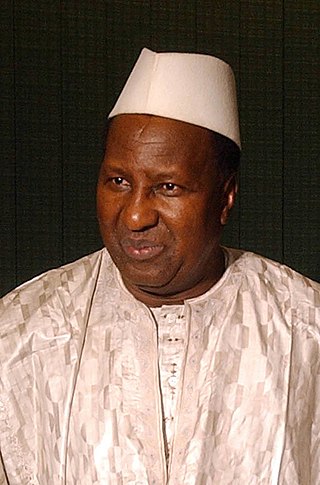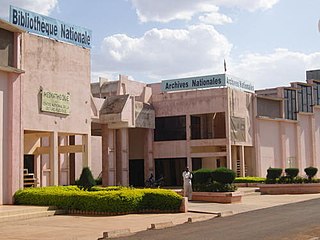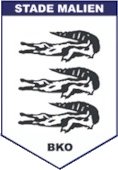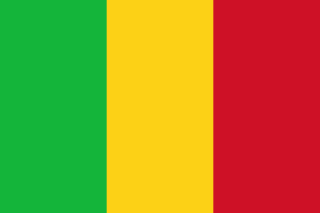A list of notable buildings and structures in Mali:
A list of notable buildings and structures in Mali:

Mali's transportation infrastructure is regarded as poor, even by regional standards, and deficiencies have limited economic growth and development. Nevertheless, improvements have been noted in the early 2000s. Most of the transportation in Mali consists of cars, planes, and boats.

Bamako is the capital and largest city of Mali, with a 2022 population of 4,227,569. It is located on the Niger River, near the rapids that divide the upper and middle Niger valleys in the southwestern part of the country.

Alpha Oumar Konaré is a Malian politician, professor, historian and archaeologist, who served as President of Mali for two five-year terms from 1992 to 2002 and was Chairperson of the African Union Commission from 2003 to 2008.

Kayes is a city in western Mali on the Sénégal River with a population of 127,368 at the 2009 census. Kayes is the capital of the administrative region of the same name. The name "Kayes" comes from the Soninke word "karré", which describes a low humid place that floods in rainy season. The city is located 420 kilometres (260 mi) northwest of the capital Bamako.

The National Library of Mali is located in Bamako, Mali.
African Photography Encounters is a biennial exhibition in Bamako, Mali, held since 1994. The exhibition, featuring exhibits by contemporary African photographers, is spread over several Bamako cultural centers, including the National Museum, the National Library, the Modibo Keïta memorial, and the District Museum. The exhibition also features colloquia and film showings. The most recent biennial took place in 2017.
Malick Sidibé was a Malian photographer from a Fulani village in Soloba, who was noted for his black-and-white studies of popular culture in the 1960s in Bamako. Sidibé had a long and fruitful career as a photographer in Bamako, Mali, and was a well-known figure in his community. In 1994 he had his first exhibition outside of Mali and received much critical praise for his carefully composed portraits. Sidibé's work has since become well known and renowned on a global scale. His work was the subject of a number of publications and exhibited throughout Europe and the United States. In 2007, he received a Golden Lion for Lifetime Achievement at the Venice Biennale, becoming both the first photographer and the first African so recognized. Other awards he has received include a Hasselblad Award for photography in 2003, an International Center of Photography Infinity Award for Lifetime Achievement (2008), and a World Press Photo award (2010).
The mass media in Mali includes print, radio, television, and the Internet.

Stade Malien is a Malian professional football and sports club based in Bamako. One of the two dominant clubs of Malian football, their eastern Bamako training grounds host other sports as well, including a successful basketball club.

Articles related to Mali include:

The University of Bamako was the flagship public university in Bamako, the capital of Mali between 1996 and 2011. It was also known as the University of Mali. University was legally established in 1993 by the merger of existing institutions of higher learning while it became operational in 1996.
Railway stations in Mali include:

The King Fahd Bridge of Bamako, Mali connects the older sections of the Malian capital to its broad suburbs on the south shore of the Niger River.

The Martyrs Bridge of Bamako, Mali connects the older sections of the city to its suburbs on the south shore of the Niger River. One of three road bridges across the Niger at Bamako, it is also known as the "Old Bridge". Opened in 1957 when Mali was under French colonial rule, it was renamed the Martyrs Bridge in 1991 following the deaths of protesters against the rule of Moussa Traoré. Martyrs Bridge connects two of the main avenues of the city. Avenue Fleuve, a broad boulevard enclosing the Square Lamumba which runs north towards the Presidential palace. From the south of the bridge runs Avenue de l'Unite Africain, the major route from the city centre south to Bamako-Senou Airport.

In Mali, football is played widely and followed avidly, football is the most popular sport in Mali. Large professional clubs and international competition draw much popular attention, and the sport is played as a pastime.
Mali has one railroad, including 729 kilometers in Mali, which runs from the port of Koulikoro via Bamako to the border with Senegal and continues on to Dakar. The Bamako-Dakar line, which has been described as dilapidated, was owned by a joint company established by Mali and Senegal in 1995, with the eventual goal of privatization. In 2003, the two countries sold a 25-year concession to run the rail line to a Canadian company, which has pledged to upgrade equipment and infrastructure.

China–Mali relations refer to the bilateral relations between China and Mali. The People's Republic of China established diplomatic relations with the Republic of Mali on October 25, 1960.

On 20 November 2015, Islamist militants took 170 hostages and killed 20 of them in a mass shooting at the Radisson Blu hotel in Bamako, the capital city of Mali. The siege was ended when Malian special forces, backed by U.S. and French personnel, launched an assault on the hotel to recover the surviving hostages. Al-Mourabitoun claimed that it carried out the attack "in cooperation with" al-Qaeda in the Islamic Maghreb; an al Qaeda member confirmed that the two groups cooperated in the attack.
1930s – 1940s – 1950s – 1960s – 1970s – 1980s – 1990s – 2000s – 2010s
The following is a timeline of the history of the city of Bamako, Mali.